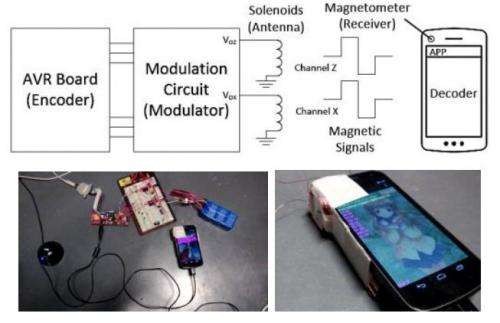System architecture (top); and prototype (bottom). Credit:
A system called Pulse uses the magnetic field sensor, or magnetometer, for the compass app in smartphones to get messages in the form of a varying magnetic field produced by a nearby electromagnet. The report in New Scientist features the work of Vassilis Kostakos and team at the University of Oulu Department of Computer Science and Engineering in Finland. They built a test electromagnet system that communicated with Android phones. They encoded data in a varying magnetic field and they could transmit items such as a web address and MIDI (Musical Instrument Digital Interface) music sequence from the electromagnet to the phone. MIDI is a standard that allows electronic musical instruments, computers and other devices to connect and communicate with one another.
Pulse is designed for off-the-shelf Android smartphones with magnetometers, and encodes data in magnetic fields."This is a live dynamic channel where information can be broadcast in real time," said Kostakos in New Scientist. Their work including the materials they used for the system is explained in detail in their paper, "Pulse: Low Bitrate Wireless Magnetic Communication for Smartphones." The paper is authored by the Oulu team along with Weiwei Jiang of the Huazhong University of Science and Technology in China. The authors said that many smartphones today have a magnetometer, commonly packaged together with GPS to establish users' direction when navigating. They said that Pulse, an alternative to NFC and QRCodes can be used on smartphones' magnetometers, i.e., magnetic compass for short -range one-way communications with a bitrate of up to 44 bits per second. They said, however, that Pulse is not intended as an outright replacement for NFC or QRCodes, but rather as a complementary protocol.
Yes, there are drawbacks. The transmission rate is quite slow, and it only works over a range of 2 centimeters. As the authors wrote, "The limited speed and bandwidth also constrain Pulse's applications." But wait, not so fast. In some instances the disadvantages would be advantages, if the system, for example, were used for Near Field Communications payments. Kostakos suggested, said New Scientist, that the magnetic messaging system could ensure the phone exchanges nothing until within 2 centimeters of the payment terminal, when the magnet would send a secure code activating the regular NFC app.
The authors wrote, "Pulse is ideal for short-lived and extremely short-distance data transfers. In payment scenarios, a short code can be transmitted via Pulse near a payment terminal to confirm or verify payment using a smartphone, by transferring a 64bit or 128bit authentication key, passcode or other token to bootstrap a higher bandwidth communications channel. At a cash machine, Pulse can be used to transmit voucher information and balance information to the user's smartphone."
As for speed, the team acknowledged in their paper that "Our prototype's magnetic data transfer is slow in comparison to Wi-Fi or Bluetooth at a mere 44 bps link speed." They said three strategies could address that, with their own issues. "First, we could use faster magnetometers that can sense magnetic flux more rapidly. Second, we could modify Android's kernel to increase the sampling rate, but that would mean that our software would not work with off-the-shelf smartphones. Third, we could add the y-axis (in addition to the x and z axes) to increase the bits per period, but that would affect the distance between the antenna and smartphone." Note that Pulse is unidirectional; it can transmit data from the prototype to the smartphone, but not the other way around, said the team.
They suggested that low-bit streaming data can be transmitted using Pulse to enable the personalization of services and applications. "As a demo, we developed a music application that can transmit MIDI-like standard music for reproduction on the smartphone." Furthermore, the authors said Pulse can be used to complement QRCodes by providing up-to-date information from digital signage, with no need for Internet access.
In September, the Oulu team will reveal more of their plans for magnetic messaging at the annual UbiComp 2014, the ACM International Joint Conference on Pervasive and Ubiquitous Computing, conference in Seattle, Washington.
More information: * Study paper: Pulse: Low Bitrate Wireless Magnetic Communication for Smartphones, www.denzilferreira.com/papers/ … bicomp2014-pulse.pdf
* UbiComp 2014: ubicomp.org/ubicomp2014/
© 2014 Tech Xplore























